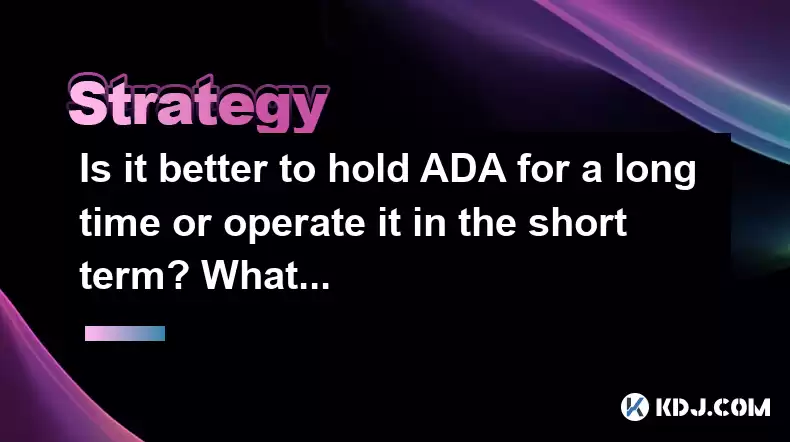-
 bitcoin
bitcoin $110918.433029 USD
-1.69% -
 ethereum
ethereum $3996.872473 USD
-2.43% -
 tether
tether $1.000594 USD
0.00% -
 bnb
bnb $1178.871834 USD
-2.38% -
 xrp
xrp $2.413973 USD
-3.47% -
 solana
solana $194.341461 USD
-4.24% -
 usd-coin
usd-coin $0.999963 USD
-0.03% -
 tron
tron $0.320092 USD
0.92% -
 dogecoin
dogecoin $0.196919 USD
-3.42% -
 cardano
cardano $0.669585 USD
-3.63% -
 hyperliquid
hyperliquid $37.485952 USD
-3.58% -
 ethena-usde
ethena-usde $1.000026 USD
-0.02% -
 chainlink
chainlink $18.018220 USD
-5.13% -
 bitcoin-cash
bitcoin-cash $523.879267 USD
-2.41% -
 stellar
stellar $0.324655 USD
-3.67%
Is it better to hold ADA for a long time or operate it in the short term? What are the advantages and disadvantages of the two strategies?
When deciding between holding Cardano (ADA) long-term or trading it short-term, consider your risk tolerance, investment goals, and market analysis to make an informed choice.
Apr 29, 2025 at 03:42 am

When considering whether to hold Cardano (ADA) for the long term or to engage in short-term trading, it is crucial to understand the distinct strategies, their potential benefits, and their inherent risks. This article will delve into both approaches, providing a comprehensive analysis to help you make an informed decision based on your investment goals and risk tolerance.
Long-Term Holding of ADA
Long-term holding, often referred to as 'HODLing,' involves purchasing ADA and retaining it for an extended period, typically several years. This strategy is based on the belief that the value of Cardano will increase over time due to its technological advancements, adoption, and overall growth in the cryptocurrency market.
Advantages of Long-Term Holding
- Reduced Stress and Time Commitment: Holding ADA long-term requires less active management compared to short-term trading. You do not need to constantly monitor market movements or make frequent trades, which can reduce stress and save time.
- Potential for Significant Gains: If Cardano continues to develop and gain more widespread adoption, the value of ADA could increase substantially over the long term. Historical data shows that cryptocurrencies like Bitcoin have provided significant returns to long-term holders.
- Benefiting from Cardano's Development: Cardano is known for its focus on research and development. Long-term holders can benefit from the potential growth and improvements in the Cardano ecosystem, such as the implementation of smart contracts and other DeFi applications.
Disadvantages of Long-Term Holding
- Opportunity Cost: By holding ADA long-term, you might miss out on potential gains from other investment opportunities. The cryptocurrency market is volatile, and other assets might offer higher returns in the short term.
- Market Volatility: The crypto market can be highly volatile, and holding ADA long-term means you could experience significant fluctuations in value. While you might believe in Cardano's long-term potential, short-term dips can be challenging to endure.
- Liquidity Risk: If you need to access your funds quickly, holding ADA long-term might not be ideal. Converting your holdings back to fiat currency can take time, and you might have to sell at a less favorable price during market downturns.
Short-Term Trading of ADA
Short-term trading of ADA involves buying and selling the cryptocurrency within a shorter timeframe, ranging from minutes to months. This strategy aims to capitalize on the frequent price fluctuations in the market to generate profits.
Advantages of Short-Term Trading
- Potential for Quick Profits: Short-term trading can offer the opportunity to make quick profits by taking advantage of the volatility in the ADA market. Traders can buy low and sell high within a short period.
- Flexibility: Short-term trading allows you to adapt quickly to market changes. If you see a better opportunity elsewhere, you can exit your ADA position and invest in another asset.
- Active Engagement: For those who enjoy the excitement of trading, short-term strategies provide an engaging way to participate in the cryptocurrency market. It can be intellectually stimulating and rewarding to analyze market trends and make timely decisions.
Disadvantages of Short-Term Trading
- Higher Risk: Short-term trading is inherently riskier than long-term holding. The market can be unpredictable, and even experienced traders can incur significant losses.
- Time-Consuming: Successful short-term trading requires constant monitoring of the market, technical analysis, and timely decision-making. This can be time-consuming and stressful.
- Transaction Fees: Frequent buying and selling of ADA can result in higher transaction fees, which can eat into your profits. It's essential to consider these costs when evaluating the viability of short-term trading.
Factors to Consider When Choosing a Strategy
When deciding between holding ADA long-term or trading it short-term, several factors should be taken into account:
Risk Tolerance
Your risk tolerance is a crucial factor in choosing a strategy. If you are comfortable with the potential for significant losses and enjoy the fast-paced nature of trading, short-term trading might be suitable. However, if you prefer a more stable approach and can handle market fluctuations over time, long-term holding could be a better fit.
Investment Goals
Your investment goals will also influence your decision. If you are looking for quick profits and are willing to actively manage your investments, short-term trading aligns with those objectives. Conversely, if you are investing for the future and believe in Cardano's long-term potential, holding ADA for an extended period might be more appropriate.
Market Analysis
Market analysis is essential for both strategies. For long-term holders, understanding Cardano's development roadmap, partnerships, and overall market trends can help you assess its potential for growth. For short-term traders, technical analysis and staying updated on market news can help you make informed trading decisions.
Practical Steps for Long-Term Holding
If you decide to hold ADA long-term, here are some practical steps to consider:
- Research Cardano: Understand Cardano's technology, its development team, and its roadmap. This knowledge will help you make an informed decision about holding ADA long-term.
- Diversify Your Portfolio: While you may believe in Cardano's potential, it's wise to diversify your investments to mitigate risk. Consider allocating a portion of your portfolio to ADA while investing in other assets.
- Secure Your Holdings: Use a hardware wallet to store your ADA securely. Hardware wallets offer better protection against hacks and theft compared to software wallets.
- Stay Informed: Keep up with Cardano's progress and any significant developments in the cryptocurrency market. This will help you stay confident in your long-term holding strategy.
Practical Steps for Short-Term Trading
If you choose to engage in short-term trading of ADA, consider the following steps:
- Choose a Reliable Exchange: Select a reputable cryptocurrency exchange that supports ADA trading. Ensure the exchange has a good track record of security and user experience.
- Set Up a Trading Account: Create an account on the chosen exchange, complete the necessary verification processes, and deposit funds into your account.
- Develop a Trading Plan: Establish clear entry and exit points for your trades. Decide on the amount you are willing to risk per trade and set stop-loss orders to manage potential losses.
- Use Technical Analysis: Utilize technical analysis tools to identify trends and potential entry and exit points. Common tools include moving averages, RSI, and MACD.
- Monitor the Market: Keep a close eye on ADA's price movements and market news. Be prepared to act quickly based on your analysis and trading plan.
Frequently Asked Questions
Q: Can I switch between long-term holding and short-term trading strategies with ADA?A: Yes, you can switch between strategies based on your changing investment goals and market conditions. However, it's essential to understand the implications of each strategy and ensure that any switch aligns with your overall investment plan.
Q: How does Cardano's staking feature impact the decision between long-term holding and short-term trading?A: Cardano's staking feature allows you to earn rewards by holding ADA in a staking pool. This can be an attractive incentive for long-term holders, as it provides an additional source of income. Short-term traders might find staking less appealing, as it requires locking up your ADA for a period, which could limit your ability to trade actively.
Q: Are there any tax implications to consider when choosing between long-term holding and short-term trading of ADA?A: Yes, tax implications can vary depending on your jurisdiction. In many countries, long-term capital gains are taxed at a lower rate than short-term gains. It's important to consult with a tax professional to understand how your chosen strategy will impact your tax obligations.
Q: How can I mitigate the risks associated with short-term trading of ADA?A: To mitigate risks, consider using stop-loss orders to limit potential losses, diversifying your trading portfolio, and only risking a small portion of your capital on any single trade. Additionally, continuous education and staying updated on market trends can help you make more informed trading decisions.
Disclaimer:info@kdj.com
The information provided is not trading advice. kdj.com does not assume any responsibility for any investments made based on the information provided in this article. Cryptocurrencies are highly volatile and it is highly recommended that you invest with caution after thorough research!
If you believe that the content used on this website infringes your copyright, please contact us immediately (info@kdj.com) and we will delete it promptly.
- BNB, Coinbase, and Record Highs: What's the Deal?
- 2025-10-16 20:45:17
- Cryptos to $50K: Can $1000 Turn Into a Fortune?
- 2025-10-16 20:45:17
- Alaska Gold Meets 2025 Token Mania: A Wild Ride!
- 2025-10-16 20:50:01
- Pudgy Penguins (PENGU) Rally Close: Will the Penguin Fly or Flop?
- 2025-10-16 20:50:01
- Avalon X: Revolutionizing Real Estate Investing with RWA Presales
- 2025-10-16 20:50:01
- Crypto Under $1 to Watch in 2025: Finding the Next Big Thing
- 2025-10-16 20:50:12
Related knowledge

Practical parameter settings for a Bitcoin multi-timeframe moving average system
Sep 18,2025 at 10:54pm
Optimizing Timeframe Combinations for Bitcoin Trading1. Selecting appropriate timeframes is crucial when building a multi-timeframe moving average sys...

How can I filter out false breakouts in Dogecoin high-frequency trading?
Sep 22,2025 at 01:00am
Understanding False Breakouts in Dogecoin Trading1. A false breakout occurs when Dogecoin's price appears to move beyond a defined support or resistan...

Techniques for identifying tops and bottoms in the Bitcoin on-chain NVT model
Sep 20,2025 at 07:54pm
Understanding the NVT Model in Bitcoin Analysis1. The Network Value to Transactions (NVT) ratio is often described as the 'P/E ratio' of the cryptocur...

What does the surge in open interest in Bitcoincoin futures mean?
Sep 20,2025 at 11:18pm
Understanding the Surge in Dogecoin Futures Open Interest1. A surge in open interest within Dogecoin futures indicates a growing number of active cont...

How can I use the Ethereum USDT premium to gauge market sentiment?
Sep 18,2025 at 11:55pm
Understanding the Ethereum USDT Premium1. The Ethereum USDT premium refers to the price difference between USDT (Tether) traded on Ethereum-based plat...

What should I do if Ethereum staking yields decline?
Sep 20,2025 at 06:18am
Understanding the Causes Behind Declining Ethereum Staking Yields1. The Ethereum network transitioned to a proof-of-stake consensus mechanism with the...

Practical parameter settings for a Bitcoin multi-timeframe moving average system
Sep 18,2025 at 10:54pm
Optimizing Timeframe Combinations for Bitcoin Trading1. Selecting appropriate timeframes is crucial when building a multi-timeframe moving average sys...

How can I filter out false breakouts in Dogecoin high-frequency trading?
Sep 22,2025 at 01:00am
Understanding False Breakouts in Dogecoin Trading1. A false breakout occurs when Dogecoin's price appears to move beyond a defined support or resistan...

Techniques for identifying tops and bottoms in the Bitcoin on-chain NVT model
Sep 20,2025 at 07:54pm
Understanding the NVT Model in Bitcoin Analysis1. The Network Value to Transactions (NVT) ratio is often described as the 'P/E ratio' of the cryptocur...

What does the surge in open interest in Bitcoincoin futures mean?
Sep 20,2025 at 11:18pm
Understanding the Surge in Dogecoin Futures Open Interest1. A surge in open interest within Dogecoin futures indicates a growing number of active cont...

How can I use the Ethereum USDT premium to gauge market sentiment?
Sep 18,2025 at 11:55pm
Understanding the Ethereum USDT Premium1. The Ethereum USDT premium refers to the price difference between USDT (Tether) traded on Ethereum-based plat...

What should I do if Ethereum staking yields decline?
Sep 20,2025 at 06:18am
Understanding the Causes Behind Declining Ethereum Staking Yields1. The Ethereum network transitioned to a proof-of-stake consensus mechanism with the...
See all articles


























![Web3 Crypto Market Morning Report: The market is in decline, altcoins have fallen by more than 5%, Binance compensation has been received, and Memes on the Bnb chain have collectively plummeted [Vic TALK Issue 1444] Web3 Crypto Market Morning Report: The market is in decline, altcoins have fallen by more than 5%, Binance compensation has been received, and Memes on the Bnb chain have collectively plummeted [Vic TALK Issue 1444]](/uploads/2025/10/16/cryptocurrencies-news/videos/web-crypto-market-morning-report-market-decline-altcoins-fallen-binance-compensation-received-memes-bnb-chain-collectively-plummeted-vic-talk-issue/68f043c9c8b44_image_500_375.webp)















































